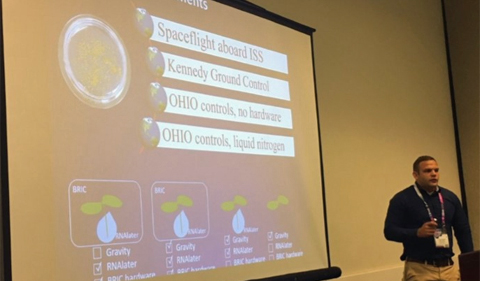Alexander Meyers, graduate student in Environmental & Plant Biology and the Molecular and Cellular Biology program, gave a 30-minute invited talk at the 2018 Committee On Space Research (COSPAR) conference July 14-22 in Pasadena, CA.
His talk was titled “Proteomic and transcriptomic analysis of Arabidopsis seedlings in microgravity reveal novel regulatory pathways.”
Co-authors are Ohio University graduate students Colin P. S. Kruse and Proma Basu; Dr. Darron R. Luesse of outhern Illinois University Edwardsville; and Dr. Sarah E. Wyatt, Professor of Environmental & Plant Biology at Ohio University.
Abstract: Low earth orbit provides a wholly unique opportunity to study plant gravity response at the molecular level. Indeed, several studies over the past decade have assessed gene expression and protein abundance under microgravity conditions. However, RNA sequencing technologies have advanced substantially in recent years, and few if any studies have comprehensively examined gene expression with the resolution provided by next generation sequencing. Additionally, pairing RNAseq data with the assessment of individual protein abundances provides a far more complete picture of the molecular environment within plants subjected to microgravity. Here, etiolated seedling were grown for three days aboard ISS in BRIC hardware. Seedlings were fixed with RNAlater, frozen at -80 °C, and returned to Earth for analysis. A series of ground controls were conducted to correct for the effects of microgravity, preservative, and growth hardware. Tissue underwent paired-end RNA sequencing and protein mass spec analysis. In total, 173 proteins and 1,974 genes were found to be differentially expressed between the space flown samples and ground controls. Further analysis revealed a general incongruity between the RNA and protein datasets, highlighting the value in using multiple molecular approaches to delineate the effects of microgravity environments. Considering all data collected, novel microgravity-induced molecular dysregulation was uncovered in post transcription regulation, light signaling, and growth-related pathways.




















Comments